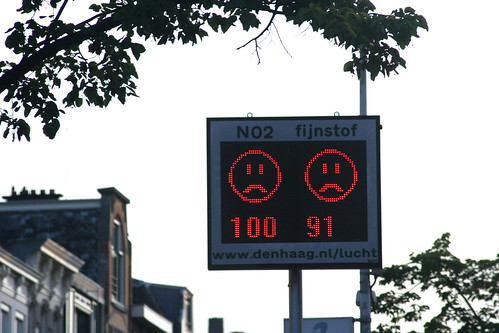EPA Sets New Standard for Nitrogen Dioxide Pollution
by Matthew Madia, 1/26/2010
The U.S. Environmental Protection Agency (EPA) yesterday revised the national air quality standard for nitrogen dioxide for the first time in 35 years. In addition to the annually-measured standard (which EPA actually kept the same) the agency will, for the first time ever, enforce a one-hour standard intended to limit short-term exposure to NO2. The new one-hour standard is set at 100 ppb (parts per billion).
Clean air advocates are happy that EPA is taking a serious approach to short-term NO2 exposure, but the limit is still too high, they say. The American Lung Association had been calling for a limit of 50 ppb. NO2 can trigger asthma attacks and cause other health problems, even over short exposure periods, the association says.
 A critical aspect of the rule is the aggressive network of air pollution monitors EPA will set up near heavily polluted roadways. (After all, you can’t enforce an air pollution standard if you don’t know how much pollution is in the air.) In a statement, American Lung Association President Charles D. Connor said, “We hope this will only be the beginning of what is truly needed—a comprehensive, multipollutant network that will routinely gather information along our highways, the place in every community that has some of the highest levels of the most dangerous pollutants.”
A critical aspect of the rule is the aggressive network of air pollution monitors EPA will set up near heavily polluted roadways. (After all, you can’t enforce an air pollution standard if you don’t know how much pollution is in the air.) In a statement, American Lung Association President Charles D. Connor said, “We hope this will only be the beginning of what is truly needed—a comprehensive, multipollutant network that will routinely gather information along our highways, the place in every community that has some of the highest levels of the most dangerous pollutants.”
Unfortunately, even the monitoring network is not without its flaws. When EPA proposed the NO2 rule back in July 2009, it said it would use the population of a metropolitan area as a trigger for placement of an air pollution monitor. At the time, EPA proposed a threshold of 350,000 people. So, if a metro area has a population of 350,000 or more, EPA would require an air pollution monitor be placed near a major road in that area. But in the final rule unveiled yesterday, the threshold is set at 500,000 people. The change means 126 monitors will be placed in metro areas around the country, instead of 165.
At this point, no one is sure what prompted EPA’s change of heart. The final rule claims the threshold was raised “after consideration of public comments,” but EPA provides no evidence that the public opposed the lower threshold. The Clean Air Council asked for an even lower threshold, possibly down to 100,000 people, according to a recap of comments in the final rule. Even Dow Chemical Company, which was pushing for a weaker one-hour standard, called the 350,000 person threshold “reasonable.”
What we do know is that the change was made very late in the game. According to this document, when EPA sent a draft version of the final rule to the White House Office of Information and Regulatory Affairs on Dec. 18, 2009, EPA intended to set the threshold at 350,000, consistent with the proposed rule. (OIRA reviews agency drafts before they are published. The review is usually the last stage in the process.) At some point between Dec. 18 and yesterday, the threshold was changed.
Stay tuned for updates.
Image by Flickr user marie-II. Used under a Creative Commons license.



